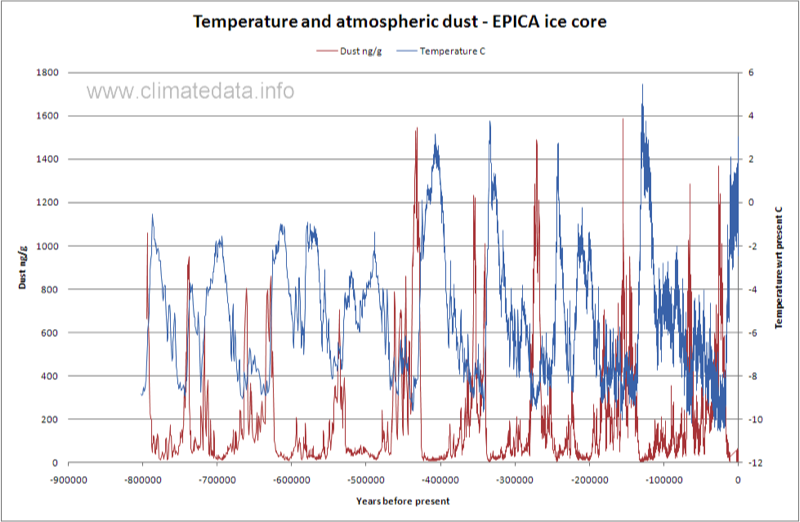AIRBORNE DUST AND TEMPERATURE
Ice cores drilled in the Antarctic provide a record of temperature and dust going back for 800,000 years. (For more information on temperature see data on ice cores).
Figure 1 reveals the variation of Aeolian (air-borne) Dust and temperature from the EPICA ice-core. This shows that there is a clear inverse relationship between temperature and aeolian dust. In general there seems to be a tendency for rates of deposition of dust to increase during an ice age and to decrease rapidly at the next warm interglacial. The concurrence in the above graph does not appear perfect due to lack of synchronicity in the estimates of ice age used for temperature and dust.
Figure 1 reveals the variation of Aeolian (air-borne) Dust and temperature from the EPICA ice-core. This shows that there is a clear inverse relationship between temperature and aeolian dust. In general there seems to be a tendency for rates of deposition of dust to increase during an ice age and to decrease rapidly at the next warm interglacial. The concurrence in the above graph does not appear perfect due to lack of synchronicity in the estimates of ice age used for temperature and dust.
http://www.climatedata.info/

It is believed that the increase in dust associated with cold periods has three causes:
Analysis of the dust shows that most of the dust deposits are from the hemisphere where the ice core was taken. On the other hand the synchronicity of the northern and southern ice-cap records suggests that the increase in desertification in ice ages was a global phenomenon. The corollary is that warm periods are associated with less desertification.
- Increase desertification,
- Increased in land area (due to falling sea levels)
- Increased winds.
Analysis of the dust shows that most of the dust deposits are from the hemisphere where the ice core was taken. On the other hand the synchronicity of the northern and southern ice-cap records suggests that the increase in desertification in ice ages was a global phenomenon. The corollary is that warm periods are associated with less desertification.